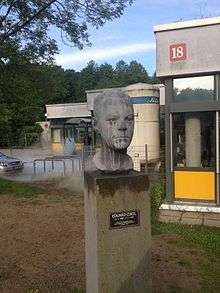Eduard Zintl
Eduard Zintl (21 January 1898 – 17 January 1941) was a German chemist. He gained prominence for research on intermetallic compounds.[1]
Eduard Zintl | |
|---|---|
 | |
| Born | 21 January 1898 Weiden, Germany |
| Died | 17 January 1941 (aged 42) Darmstadt, Germany |
| Nationality | German |
| Alma mater | University of Munich |
| Known for | Zintl phase |
| Scientific career | |
| Fields | Inorganic chemistry |
| Institutions | University of Munich, Technische Universität Darmstadt |
| Doctoral advisor | Otto Hönigschmid |
Family background
After his family moved from Weiden and Bayreuth to Munich and after he had finished school he was drafted for military service during World War I. At the age of 21 he started studying at the University of Munich with Otto Hönigschmid. He was an excellent student, and later became an assistant for Otto Hönigschmid, head of the German atomic weight laboratory.[2]
Career
He earned his PhD in 1923, at the age of 25, with a thesis on the molar mass of bromine. He stayed with Otto Hönigschmid's group, where he was involved in the supervision of PhD students, for example Josef Goubeau and Günther Rienäcker. From 1928 till 1933 he was professor of inorganic chemistry at the University of Freiburg. During this period he studied the structure of complex anions formed by metals in a solution of sodium in ammonia. [Na(NH3)x]+4[Pb9]4− is one of the examples he discovered.
Working in an atomic weight laboratory as a student assistant had provided him a lot of experience with chemical elements and how they react with each other. He noted that the atomic volume contraction between these compounds were formed and it could indicate cation formation.[3]

Work at Darmstadt
In 1933 he moved to a position at the Technische Universität Darmstadt, where a new building for inorganic and physical chemistry was planned and built. The research on complex anions lead him to the discovery of the Zintl phases. The structure of Zintl phases were ionic, and the structure of the anion (aka Zintl ion) could result an electronic state. His study focused on intermetallic compounds and how the electron could be transferred from a more electropositive metal[5]. In the Zintl phase the structure of the Zintl ion (polyanion) should be similar to an isoelectronic element. For example, in Na2Tl the polyanion is tetrahedral (Tl4)8− similar to the phosphorus molecule P4.
Further reading
- "Eduard Zintl – discoverer of Zintl phases - World Of Chemicals". www.worldofchemicals.com. Retrieved 6 November 2017.
- "Eduard Zintl". memim.com. Retrieved 6 November 2017.
- Fässler, Thomas F. (2011). Zintl Phases: Principles and Recent Developments. Springer. ISBN 9783642211508. Retrieved 6 November 2017.
References
- Zintl, E. (1939). "Intermetallische Verbindungen". Angewandte Chemie. 52: 1–6. doi:10.1002/ange.19390520102.
- H. W. Kohlschütter (1941). "Eduard Zintl, Lehre und Forschung". Naturwissenschaften. 29 (17): 240–244. Bibcode:1941NW.....29..241K. doi:10.1007/BF01479156.
- F. Laves (1941). "Eduard Zintls Arbeiten über die Chemie und Struktur von Legierungen". Naturwissenschaften. 29 (17): 244–255. Bibcode:1941NW.....29..244L. doi:10.1007/BF01479157.
- Otto Hönigschmid (1942). "Eduard Zintls Lehrjahre in München". Berichte der deutschen chemischen Gesellschaft. 75 (5): A40–A44. doi:10.1002/cber.19420750532.
- He, Hua; Tyson, C.-T.; Bobev, S. (2011). "New compounds with (As7)3- Clusters: Synthesis and Crystal Structures of the Zintl Phases Cs2NaAs7, Cs4ZnAs14 and Cs4CdAs14". Crystals: 87-p98. doi:10.3390/cryst1030087.CS1 maint: uses authors parameter (link)
- Fässler, Thomas F. (2011). Zintl Phases: Principles and Recent Developments